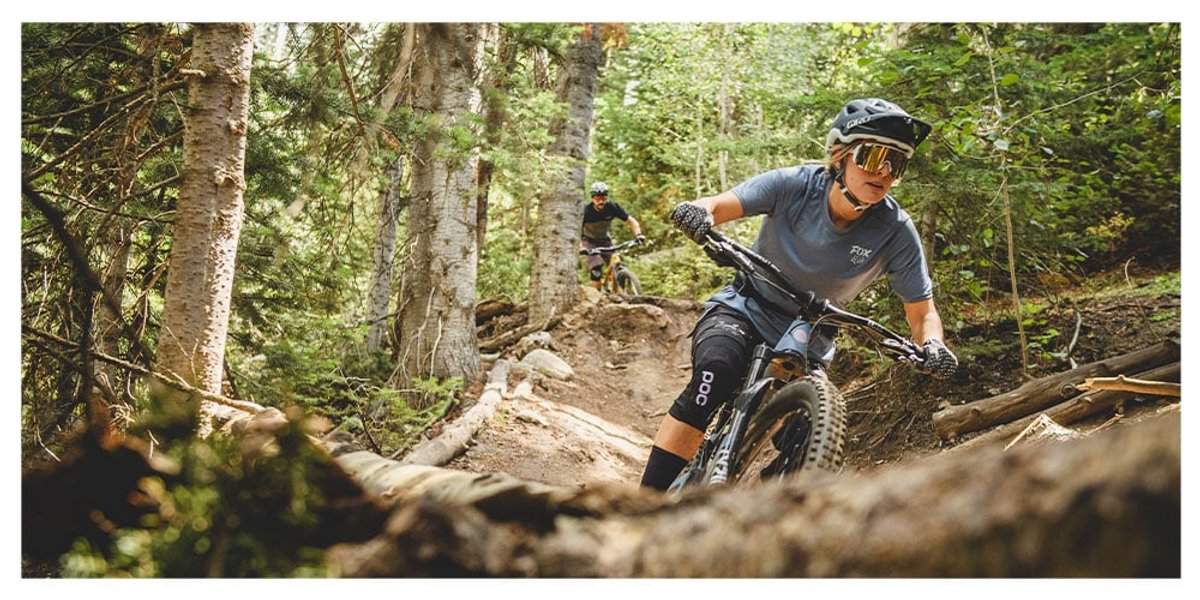Mountain Bike Buying Guide
Everything From XC Machines To Enduro Rigs
Buying a mountain bike can be overwhelming—especially with seemingly endless options in every category, confusing suspension terminology, and geometry designs that leave you with multiple size options based on your height. Our goal is to guide you through the different categories of bikes, wheel sizes, suspension designs, sizing, and more. And if you get to the end of this and are still unsure what bike is best for you, go ahead and call or chat with one of our Gearheads who can help you find a bike that fits you to a T.
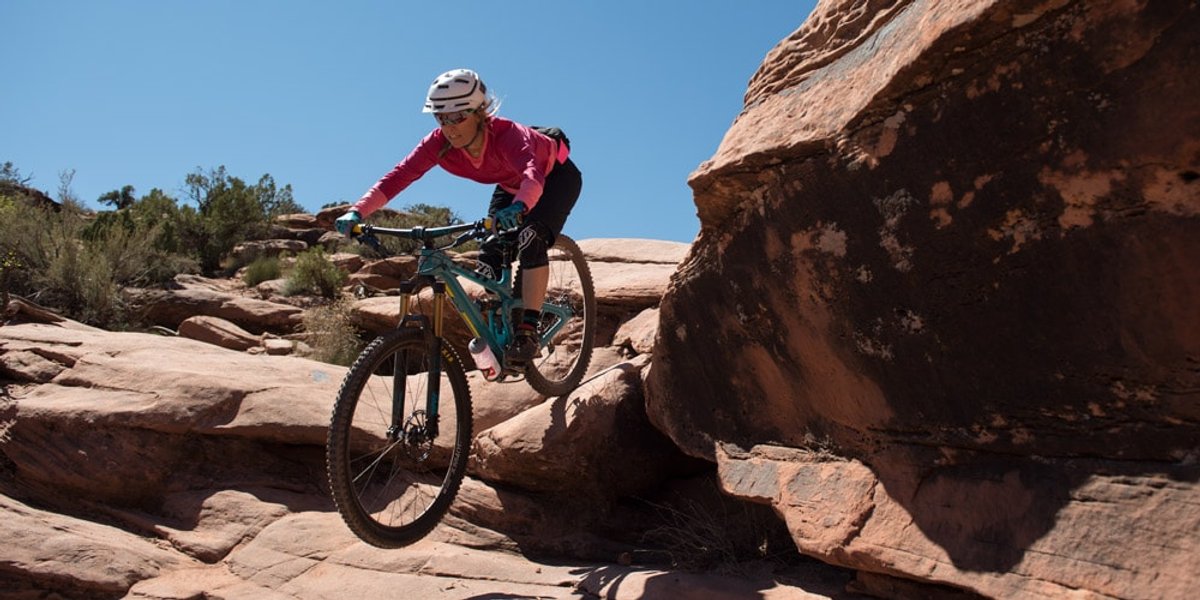
Mountain Bike Categories
Cross-country
The longest-standing member of the MTB family is the cross-country bike (aka XC bike), which is optimized for endurance and speed, rather than aggressive descending. While XC bikes are used for cross-country racing, they’re also a user-friendly option for newer riders.
XC Bike Key Features:
- Front Suspension: 100–130mm of travel
- Rear Suspension: Hardtail (0mm)–120mm of travel
- Weight: ~28lb and below
- Most Common Wheel Size: 29in
- Most Common Tire Width: 2.2–2.4in
Some cross-country bikes are hardtails which mean they don’t have any rear suspension, or travel. Hardtails are a great entry-level option because they tend to be more affordable, and you can go longer without maintenance. The models that do have rear suspension have the least amount of rear-wheel travel among MTBs so that XC bikes retain as much momentum as possible under pedaling power.
Gearhead Tip: Travel is the amount of suspension that the shock or fork provides, and it’s usually provided in millimeters. For example, a cross-country bike might have 120mm of rear wheel travel, and 130mm of fork travel.
Full-suspension XC bikes deliver superior rear-wheel traction to hardtails, whether tackling steep climbs or railing loose corners. The maximum amount of rear travel you’ll usually find on an XC bike is 120mm, which tends to be found on more endurance-focused bikes, while front suspension forks range from 100-130mm of travel.
When it comes to wheel size, cross-country bikes typically utilize 29-inch wheels for their ability to hold momentum over mixed trail surfaces, from smooth singletrack to rocks or roots. From a geometry standpoint, cross-country bikes have a steep and short design, putting the rider in an efficient pedaling position that also lets them easily maneuver the bike. In most cases, XC bikes are the best option for riders who care more about logging miles than tackling gnarly terrain.
While most cross-country bikes on the market fall solidly into the categories of race and endurance-style bikes, downcountry bikes are starting to make a case for becoming their own category. Downcountry bikes are still lightweight and highly efficient, but we typically find 110mm–120mm of rear travel and 120mm–130mm of front travel for better downhill performance. These bikes are best described as a cross between a cross-country bike and a trail bike.
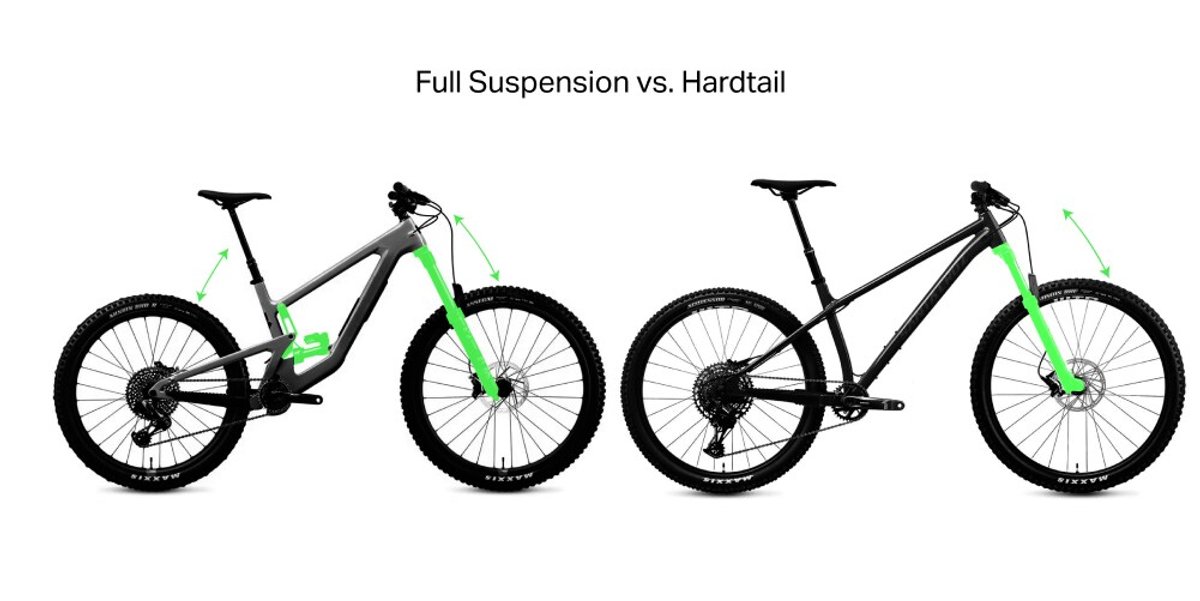
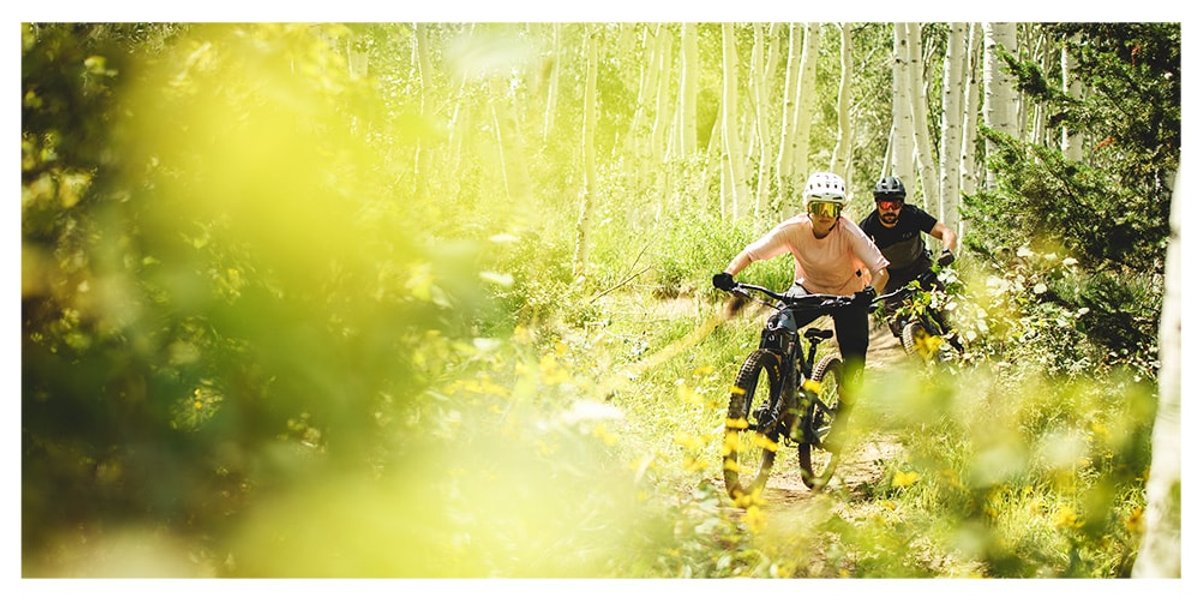
Trail
Our next category is trail bikes, which utilize a balanced design to tackle anything from lift-assisted bike parks to burly trail rides with lots of elevation gain. Their versatile performance makes them the most popular option when choosing a bike. They’re well-suited for newcomers to the sport and seasoned MTB veterans alike.
Trail Bike Key Features
- Front Suspension: 130–160mm of travel
- Rear Suspension: Hardtail (0mm) or 120–150mm of travel
- Weight: Varies (28–35lb)
- Most Common Wheel Size: 29in or MX
- Most Common Tire Width: 2.3in+
Trail bikes range from 120–150mm of rear travel, supplying balanced traction for climbing up the mountain and plenty of support for dropping into committing descents without sacrificing playfulness. Often described as “mid-travel” bikes, trail bikes are known for their middle-of-the-road suspension that performs equally well on undulating or near-vertical terrain. A few hardtail bikes fall into the trail bike category for a more challenging ride.
Straddling either end of the wheel-size debate, trail bikes tend to feature 29-inch wheels for their rollover ability in spicy terrain. Mixed-wheel trail bikes offer a no-compromise design between rollover ability and intuitive cornering, with an extra playful ride feel. A few 27.5-inch wheel options remain for those looking for user-friendly cornering or a bike for smaller riders.
When it comes to geometry, trail bikes are becoming longer and slacker for stability, which is made possible by ever-improving suspension technology that keeps these big bikes playful. If you’re a versatile rider in the market for an MTB quiver of one, a trail bike is likely your best bet.
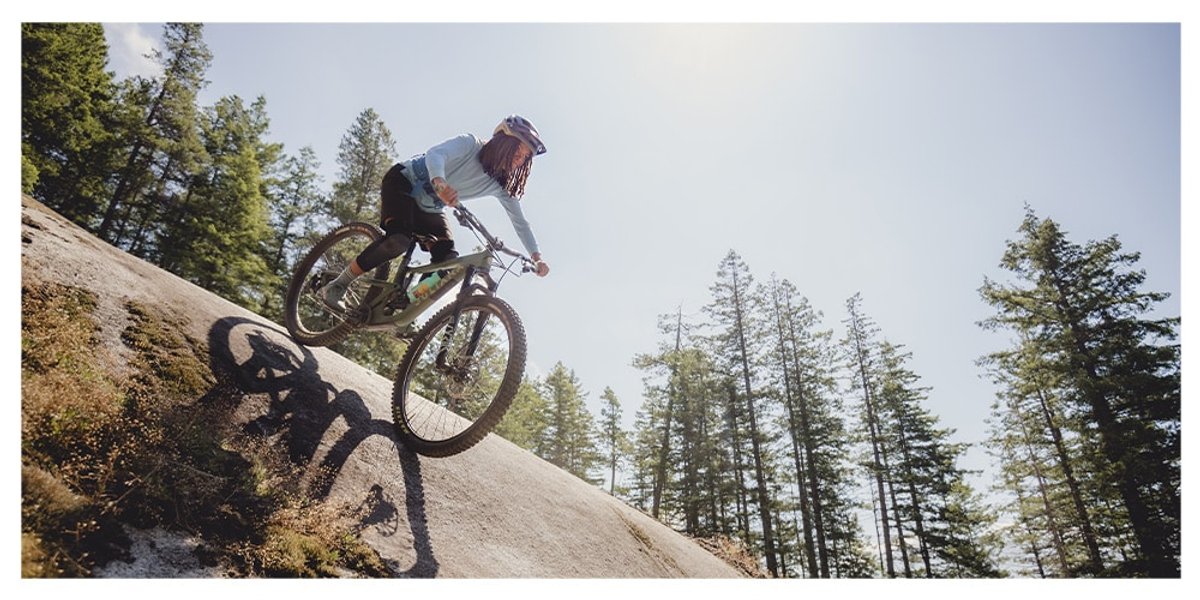
Enduro
Enduro bikes are hard-hitting and downhill-oriented, yet they are still capable of getting up the mountain—which is what’s required in an enduro race setting. While they’re race-ready, these highly versatile shredders are also great for the rider who’s really in it for the descent and dabbles in the downhill parks, too.
Enduro Bike Key Features:
- Front Suspension: 160–180mm of travel
- Rear Suspension: 150–170mm of travel
- Weight: Varies, but anywhere from 32–38lb or more
- Most Common Wheel Size: 29in, with some 27.5in and mixed options
- Most Common Tire Width: 2.35–2.6in
Ranging from 150mm to 170mm of rear travel, enduro bikes provide maximum descending traction and bottom-out resistance for rough descents. In the enduro category, 29-inch wheels are starting to rocket to the top for their ability to carry momentum over rough and rocky terrain, but some 27.5-inch bikes still hold their own thanks to their intuitive cornering and focus on agility. Mixed-wheel setups are also becoming more popular in the enduro category, giving racers the best of both worlds.
Since they’re heavier, enduro bikes inherently require more energy to get up the mountain, but they offer descending stability that makes them perfect for shuttling and riding the bike park. They’re also a great option for riders who don’t mind slowing down on the ascent to make the most of the downhill. Enduro bikes are inherently big and slack, with long wheelbases to provide maximum stability for letting off the brakes in steep, gnarly terrain.

E-MTBs (E-Mountain Bikes)
We like to think of e-MTBs as our own personal chairlift that lives in our garage. E-bikes offer battery-powered pedal-assist technology to propel you up the mountain, leaving you with more energy for the fun part (the descent), and allowing you to get more miles in.
E-MTB Key Features
- Front Suspension: 150–180mm of travel
- Rear Suspension: 130–180mm of travel
- Weight: 40+ lbs.
- Most Common Wheel Size: Mixed wheel, 29in
Since e-bikes rely on their motors for climbing, they typically lean towards longer suspension travel numbers. Our range of e-bikes spans from 130mm to 180mm of rear-wheel travel, making them capable on both rolling trails and steep, techy descents.
The mixed-wheel size is the most popular option for e-bikes since the smaller diameter 27.5-inch rear-wheel adds some playfulness to these 40lb+ machines. The burly 29-inch wheel up front makes it easier to get up and over rock ledges and also improves cornering traction.
E-Mountain bikes are a great option for riders who want to roam further into their local trail networks. They also make the sport more accessible for people with limited mobility or heart rate restrictions from various health conditions. Not all trails are e-bike friendly, so make sure to do your research before heading out there to be a courteous trail user.
Brands To Know
- Santa Cruz: Offers a massive range of bikes from XC race bikes to long-travel downhill and enduro rigs
- Juliana: Sister company to Santa Cruz, offers a smaller range of bikes that are tuned for smaller, lighter riders than their Santa Cruz counterparts
- Specialized: One of the most recognizable bike companies, offerings include everything from ultralight carbon hardtail XC bikes to affordable alloy trail bikes
- Yeti: Known for their high-end carbon frames and unique suspension design
- Ibis: Offers alloy and carbon options of everything from World Cup-winning XC bikes to enduro slayers
- Pivot: Currently only offers carbon bikes with options from cross-country to long-travel enduro rigs
- Norco: Practical yet refined, these Canadian-designed bikes take a dirt-first approach to every bike
Carbon Versus Aluminum, A Debate As Old As Time
Many bikes on the market today come in both alloy and carbon frame options, so you might be wondering if it’s worth the extra money to upgrade from an aluminum frame to a carbon one just to save a bit of weight. You’re definitely going to appreciate the lightness of carbon if you do a lot of climbing, but there’s more to the equation than that:
- Carbon is extremely strong—frame manufacturers have built frames that their fatigue testers can’t bring to failure.
- Carbon has a longer fatigue life than aluminum, meaning your frame can go through exponentially more flex cycles before failing.
- Probably the most amazing property of carbon is its ability to dampen trail vibrations creating an extremely smooth trail feel.
So, while carbon is absolutely the more premium frame material and worth investing in if you’re a weight-conscious rider or have racing goals and dreams, most riders will do just fine on aluminum. Furthermore, if you’re shredding on a budget, you can always elevate your aluminum frame with lightweight carbon wheels, as well as the best possible drivetrain, suspension, and brake components. Remember, having a heavier bike isn’t really a big deal since fitness and skills are much more important than weight.
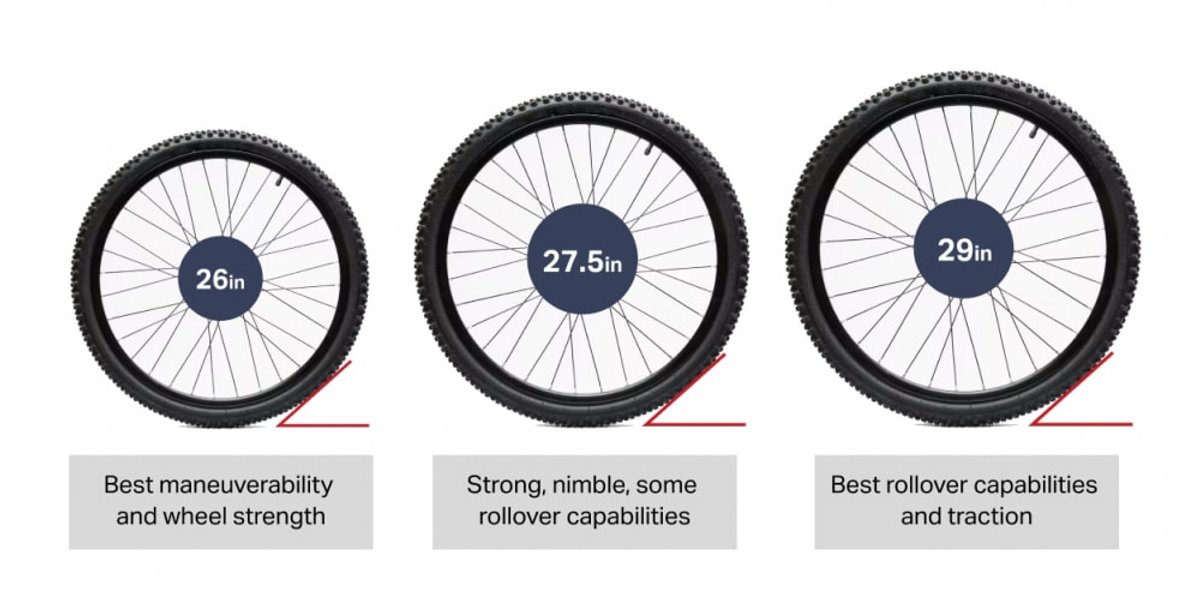
Two And A Half Wheel Sizes…Kinda
Mountain bike wheels are referred to by their diameter in inches, and over the past five years, the 29-inch wheel, aka 29er, has taken a seat at the head of the table, but bikes with 27.5-inch and mixed wheel setups remain relatively common out on the trail. In general, a larger wheel creates a smaller angle of attack to quickly roll up and over obstacles and has an overall larger contact patch with the ground. This means that bigger wheels roll more efficiently, have better straight-line speed, and in theory, more traction. On the other hand, smaller wheels are nimbler for better cornering and accelerate faster out of corners on tight and twisty trails.
- 29-inch: Now the most common wheel size, 29ers are fast rolling and provide a shallow angle of attack to easily roll up and over rocks and logs. This also means they are more forgiving with line choice for newer riders, but they do sacrifice agility in corners and take a bit longer to get up to speed from a stop. 29ers are found everywhere, from short travel XC race machines like the Exie to long-travel enduro smashers like the Firebird.
- 27.5-inch: Before the rise of mixed wheel setups, 27.5-inch wheels were considered to be the best of both worlds. Full 27.5in setups are now typically found on more playful nimble bikes and freeride specialists like the SB165, along with some long-travel enduro bikes like the Mach 6. 27.5inch wheels are typically combined with wider tires to achieve a larger contact patch for better traction.
- MX, aka Mixed Wheel, aka Mullets: With the rollover ability of a 29er up front and the agility of a 27.5in wheel in the back, the MX setup delivers the best of both worlds. This is becoming extremely common on enduro bikes such as the Nomad and playful trail bikes such as the 5010.
- 26-inch: Although it’s the classic MTB wheel size, 26-inch wheels are primarily reserved for dirt jumpers and youth bikes at this point.
Bike Fit Is Everything
The best mountain bike is the one that fits you correctly, so while the type of bike you buy is important, it is also crucial to remember that a poorly fitting bike can transform your dream bike into an unfortunate investment. Fine-tuning saddle height, stem length, crank sizes, and handlebar position are all essential, but these details won’t fix having the wrong frame size. Too small, and the bike can be twitchy on technical descents and uncomfortable for longer rides. Too big, and the bike can seem sluggish through tight switchbacks and lack playfulness.
Every manufacturer’s sizing is unique, and while their size recommendations are a great starting point, you should also take into account that your body is unique too. Factors like inseam length, flexibility, prior injuries, and riding style can all influence your fit, and it’s a good idea to mention them to a Gearhead so they can factor them into your sizing decision.
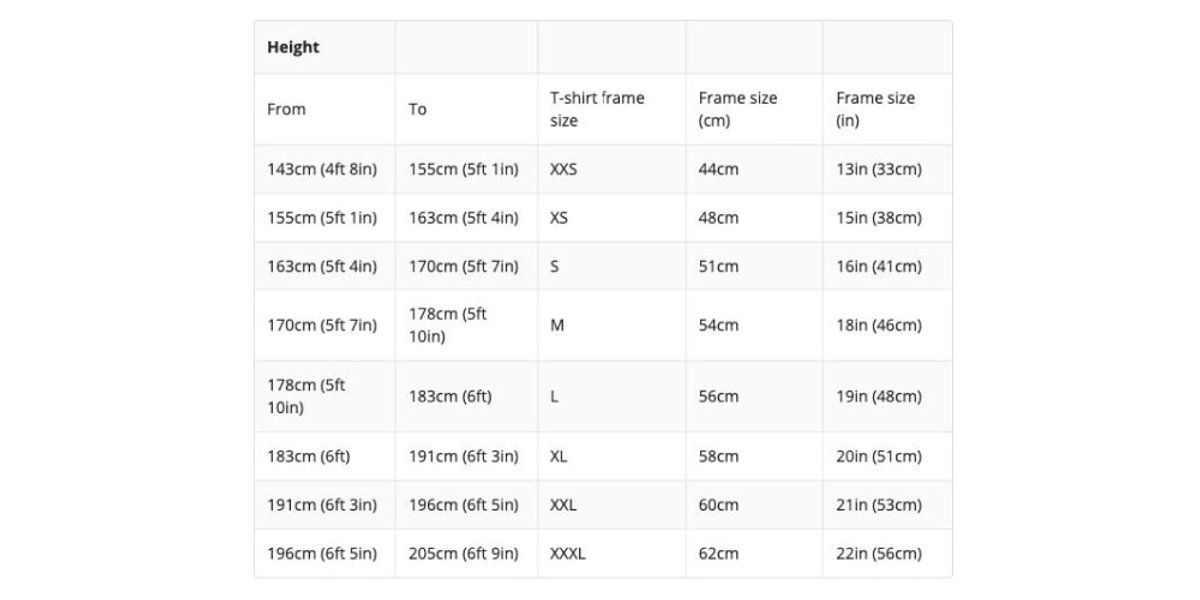
Geometry Numbers to Consider When Deciding on Size
- Reach is the distance between the center of the head tube and the bottom bracket. This provides the best idea of how roomy the cockpit will feel.
- Standover height is the distance from the ground (where the tires touch) to the center of the top tube. You’ll want at least 2 inches between the top tube and your crotch for a comfortable fit. As manufacturers develop lower and lower standover heights, most people will find themselves in a range of sizes rather than just one size that fits them.
- Effective top tube length is the horizontal distance between the top of the bike’s head tube and the center of the seat post.
- Chainstay length is the distance between the center of the bottom bracket and the rear axle. Some manufacturers keep this the same for every size, while others use size-specific chainstay lengths to create a consistent ride feel across their entire size range. Typically a shorter chainstay length leads to a more nimble and playful ride feel.
- Wheelbase is the distance between the front and rear axle. This is something you want to take into consideration when looking at the terrain you’ll be riding.
Gearhead tip: When you fall in between sizes for a particular bike, sizing up or down will change the ride feel significant. Sizing up typically comes with a longer reach and therefore a longer wheelbase. This can be beneficial when you’re looking for a stable bike with plenty of room to take on high-speed, technical descents, or you need extra reach to accommodate a proportionally longer torso. Also, if you happen to be graced with incredible flexibility, a larger size will allow you to get into a much more aggressive riding position. If you like to whip and flick your way down the trail, or are riding terrain with tight, technical low speed descents, think quintessential east coast riding—sizing down will be a better option. A smaller size will be nimbler on tight switchbacks and offer a less aggressive riding position that can be easier on the body when riding for long periods of time. A smaller bike will also be more maneuverable in the air for freeride/freestyle riding.
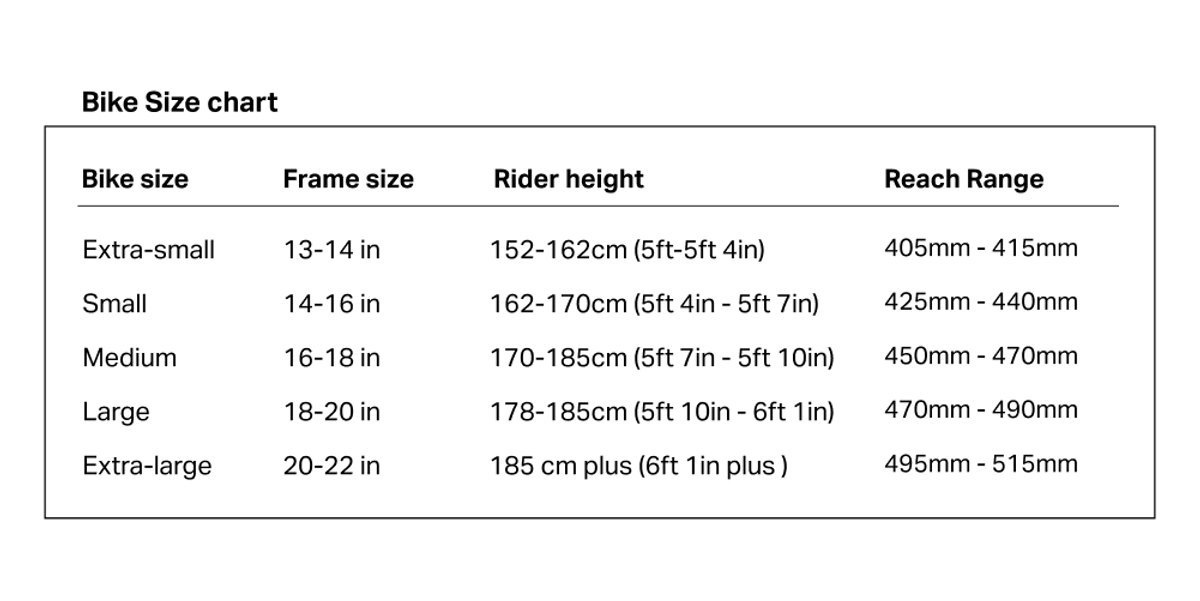
Rear Suspension Systems Explained
With so many different suspension designs on the market, it might be tough to sort out the strengths of each design and how they will affect the performance of your bike on the trail. Unless you’re riding a hardtail mountain bike with no rear suspension, the two main components of rear suspension are the shock and the linkage. Each design affects pedaling efficiency, impact absorption, and braking efficiency differently. But before we dive into our top brands’ suspension designs, there’s a few terms we need to define.
- Anti-squat affects how your weight influences the bike’s suspension movement while you’re descending and pedaling. With too much anti-squat, your ride will feel extremely harsh while you’re taking on rough trails and chunky downhill tracks. Too little, and you’ll experience inefficient pedal bob on climbs and flat sections. Most manufacturers will tune their suspension design to provide a lower percentage of anti-squat as the bike gets deeper into its travel to create a plusher feel over gnarlier terrain.
- Anti-rise affects how your bike’s suspension moves while braking. When you grab the brake and decelerate rapidly, your weight transfer quickly pushes you forward. Anti-rise counteracts this force by compressing the suspension to keep your bike planted firmly on the trail so that you’re not white-knuckling it down the steeps. Too much anti-rise, and your bike will compress too much and track unpredictably. Not enough anti-rise, and you’ll end up going over the bars. The ideal percentage of anti-rise depends on the purpose of the bike.
- Sag is the amount of suspension compression that is used up when you are sitting stationary in a riding position. While each manufacturer has specific sag percentages that optimize their bikes’ rear suspension, often that number is between 20 and 30% of the rear travel.
- Instant Center is the point on the bike that the rear axle pivots around as the suspension compresses. This dictates how the rear axle, and everything attached to it moves while also influencing anti-squat, anti-rise, and pedal kickback at any given point in the travel.
Gearhead tip: When discussing your dream bike setup with your Gearhead, be sure to mention how much you weigh, including your hydration pack, so that we can set up your suspension with just the right amount of sag so that you can get the most out of your new bike.
Now to dive into the wild world of suspension design. We’ll lay out the main suspension designs utilized by some of our brands, along with the characteristics of each design.
Yeti Switch Infinity
Yeti’s proprietary Switch Infinity linkage is a version of the classic 4-bar system where the lower pivot slides up and down a pair of vertical shafts, and the upper link rotates clockwise as your suspension compresses. This decouples chain and suspension forces, providing an intuitive and efficient ride feel. In the beginning and middle of the travel, Switch Infinity moves upward for an incredibly efficient pedaling platform. As you get deeper into your bike’s travel, Switch Infinity moves downwards, dropping the amount of anti-squat, which gives you an amazingly supple feel, and allows the suspension to move freely over technical terrain without bottoming out.
Santa Cruz & Juliana: VPP & Superlight
Santa Cruz, and their sister company Juliana, utilize two different suspension designs depending on the intended use of the bike.
The Virtual Pivot Point, aka VPP, suspension system maximizes the balance between pedaling efficiency and the right amount of suppleness for every ride. Short, counter-rotating links connect the front and rear triangles delivering a pivot point that isn’t constrained by a static instant center. This allows the engineers to fine-tune each bike’s suspension depending on the type of terrain it’s intended for, whether that’s hard charging enduro or high-speed singletrack.
Superlight Suspension, found on the Blur and the Wilder, translates as much energy as possible into forward movement. This unique design utilizes flexible seat stays to deliver just the right amount of traction without extra weight and a more efficient forward drive. This provides you with the supportive pedaling platform and traction needed to win races.
Specialized FSR & Flexstay
Specialized also utilizes different suspension designs depending on the style of riding that the bike is intended for.
The FSR suspension design is a version of the classic Horst Link design that isolates chain loading from braking loads for incredible efficiency. This allows your suspension to compress and rebound freely through rough terrain for more traction and improved bike control. FSR also doesn’t sacrifice small bump sensitivity for the ability to take big hits, so you can ride with absolute confidence through gnarly chutes and technical rock gardens. Specialized also tunes their suspension to provide an efficient pedaling platform so that you’re not feeling bogged down climbing back up to the top for a second lap.
The Flexstay suspension design is a linkage-driven single pivot design that relies on flex point on the seat stay right above the brake mount. This eliminates rear-end pivot hardware while still allowing for rear suspension travel. This is combined with a one-piece rear triangle for improved torsional and lateral stiffness, providing an incredibly efficient pedaling platform and ultra-responsive ride feel.
Ibis & Pivot: DW-Link
DW-Link suspension is a version of the twin-link suspension design that’s designed and patented by the suspension genius Dave Weagle. Developed for the ultimate combination of pedaling efficiency, rear wheel traction, and bump absorption, DW-Link will give you an overall balanced ride feel with minimal pedal bob and pedal kickback. The location of the instant center perfectly balances traction and stability when you need to come to a stop quickly, while the short, stiff likes allow for high strength-to-weight ratios.
High–Pivot Suspension Designs
High-pivot suspension designs are typically seen on long-travel enduro bikes, and feature an idler pulley that sits above and slightly behind the front chainring. This design provides a rearward axle path that eats square-edge boulders for breakfast and allows manufacturers to create enduro bikes that pedal incredibly efficiently. Bikes with high-pivot suspension also typically have incredible small bump sensitivity and high-speed stability, so you’re able to carry more speed and momentum through technical sections without getting hung up. Plus, thanks to the idler pulley, you won’t experience annoying kickback through chunky terrain.
What About Kid’s Bikes?
Little shredders need a bike that is actually designed for them, not just a shrunken version of an adult bike. A lot of manufacturers are now making kid‘s mountain bikes with all the same features as their adult models, but with kid–friendly features such as 24-inch or 26-inch wheels, softer suspension tunes, and gearing options that are suited for their abilities. Today’s kid’s bikes are just as capable as their larger counterparts on the XC course and at the bike park, so their skill progression isn’t limited by their bike.
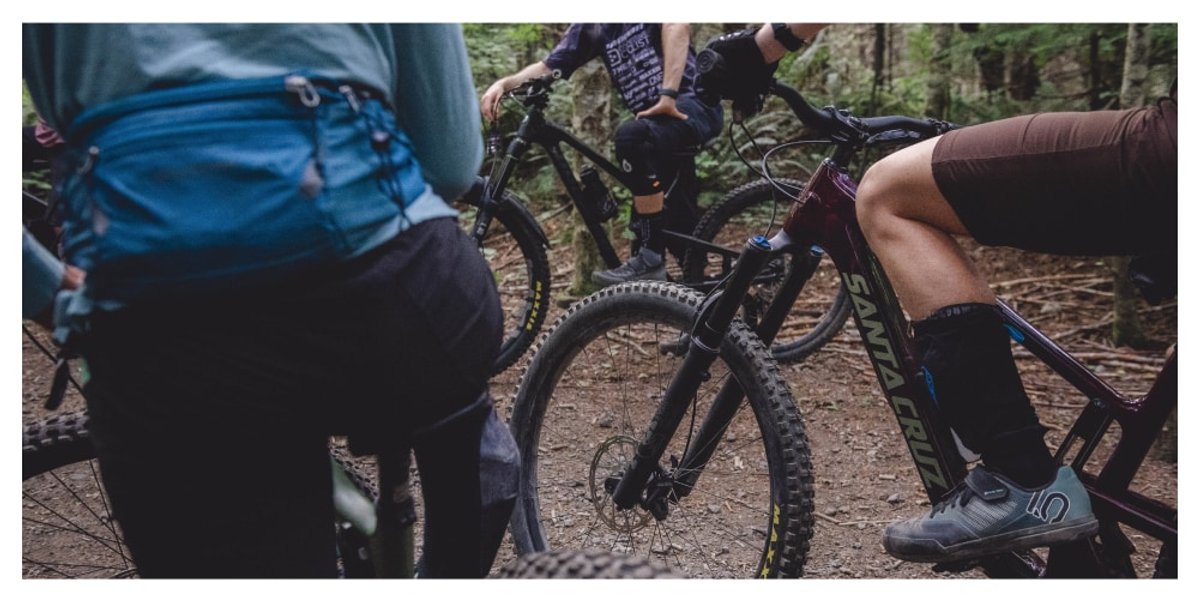
Other Gear You’ll Need To Get Out There
- Helmet: We suggest a helmet with MIPS for better impact protection and tons of ventilation for staying cool on your ride.
- Pedals: Most bikes don’t come with pedals, so whether you choose platform pedals or clipless, there’s no shortage of great options available.
- Shoes: Flat-soled grippy shoes and platform pedals go hand in hand, while high-tech 2-bolt shoes pair with clipless pedals.
- Gloves: Padding or no padding is a matter of personal preference, but most mountain bike gloves offer full finger coverage for better protection against brush and crashes.
- Chamois/Liner: Your comfort can make or break your ride, so we recommend picking up a pair of liner shorts with a comfortable chamois to cushion your ride. There are lots of women’s specific options, as well as men’s specific.
- Hydration Pack: Staying hydrated is key to a successful ride, so whether you choose a hip pack or a more traditional backpack style, a hydration pack will allow you to carry water, tools, and more.
Repair Kit: Mechanical issues happen to everyone, so don’t get stranded because you don’t have the tools you need to fix a flat or a broken chain.
Gearhead tip: When putting together your trailside repair kit, throw in a dollar bill or nutrition wrapper to help patch up a sliced sidewall so you can get back to the trailhead. Mini rolls of duct tape come in clutch too, for everything from quick repairs to makeshift bandages.
Informative Links
- Bikes
- Helmets
- Pedals
- Top Shoe Picks
- Our 30-Day Guarantee
- Demo a bike at Marty’s By Backcountry!
- Bike Sizing Hack
FAQ
Q: What should you know before hitting the trails?
A: Before heading out on the trail, be sure to check your local trail regulations regarding riding in wet conditions, off-leash dogs, and directional trails. You should also understand that hikers always have the right of way, and uphill bike traffic has the right of way to downhill bike traffic.
Q: How often should you clean your bike?
A: When it comes to deep cleaning, it really depends on how often you’re riding. However, at the very least, you should rinse off your bike after every ride, especially after particularly dusty or muddy rides. And please, don’t use a pressure washer or take your bike through the car wash.
Q: Do you really need bike-specific shoes?
A: While many mountain bike shoes look exactly like our favorite skate shoes, most have bike specific features, like stiff soles and special rubber compounds, that make your ride way more enjoyable. The Gearhead favorite Five Ten Freerider features the MTB-specific Stealth S1 rubber compound and tread that is engineered to give you the best pedal grip possible, while others add features like toe bumpers to protect your toes from rock strikes and carbon plates in the midsole to improve power transfer.
Q: What the heck is a flip-chip and what does it do?
A: A lot of bike manufacturers use a “flip– chip” on the rear suspension linkage that allows you to adjust the geometry of the bike just slightly to suit the trails you’re riding. Typically, adjusting the flip chip from the low to the high position increases the bottom bracket height along with steepening the head tube and seat tube angles. So, for those who really like to tinker, bikes with a flip chip allow you to really dial in your ideal ride setup.
